Wed 20 Mar 2013
Reviewed by Dan Stumpf (Book/Film): VICTOR CANNING – The House of the Seven Flies / The House of the Seven Hawks (1959).
Posted by Steve under Action Adventure movies , Reviews[14] Comments
VICTOR CANNING – The House of the Seven Flies. Hodder & Stoughton, UK, hardcover, 1952. Mill-Morrow, US, hardcover, 1952. Berkley #F730, US, paperback reprint, 1963.
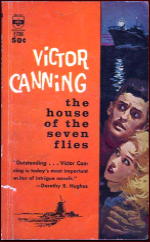
THE HOUSE OF THE SEVEN HAWKS. MGM, UK, 1959. Robert Taylor, Nicole Maurey, Linda Christian, Donald Wolfit, David Kossoff, Eric Pohlmann. Screenwriter: Jo Eisinger, based on the novel The House of the Seven Flies, by Victor Canning. Director: Richard Thorpe.
Victor Canning’s THE HOUSE OF THE SEVEN FLIES (Morrow, 1952) has intrigued me for various and sundry reasons since I came across it in my late teens, but I should tell you for starters, it’s pretty much a generic adventure/crime novel of its time, with little to distinguish it from a dozen others.
The story opens in 1944 with some Nazi big-wig looting valuable jewels from a Dutch bank—or trying to; the boat he’s leaving in gets sunk in the canals near a city called Veere and the treasure is lost forever.
Yeah (as they say) right.
The story picks up again in 1952 with Roger Furse, an American ex-serviceman now operating a charter boat in the North of England. Like any hero in this sort of thing, Roger’s a straightforward guy, but he’s not above bending the law a bit, so when a Dutchman who chartered the boat for a bit of coastal mucking about offers him extra to take him across the North Sea to the Dutch town of Veere, Roger doesn’t need much persuading. But when the Dutchman dies (mysteriously, but apparently of natural causes) Roger decides he should make sure he’s not carrying anything incriminating, goes through the man’s baggage and finds (you guessed it) a map to the “lost†treasure.
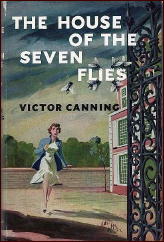
Whereupon Canning rounds up the usual complications: a cute-perky-bouncy young lady who was working with the Dutchman to recover the loot; a lugubrious police detective who tells Furse that his passenger was murdered before he ever got on board, victim of a slow poison; a showy crook with an entourage of nasty thugs, and a lovely femme fatale-type who may have killed the Dutchman.
Having assembled his cast, Canning puts them through the usual paces: Furse and the cute girl fall in love; the Dutch cop plods patiently; the showy crook offers bribes and threats; his hired nasties get tough, and the femme tries seduction. We get a couple of chases (well-handled, I must admit) a couple fights (likewise) and some sea-going stuff that Canning handles particularly well, all capped by the usual ending.
Okay so the first thing that intrigues me about this book is the title; who-the-hell would call a book THE HOUSE OF THE SEVEN FLIES? Who would publish anything with a title that connotes dull classics and household pests? Who did they think was going to buy anything labeled THE HOUSE OF THE SEVEN FLIES? I mean I wrote a book a couple years ago called EASY DEATH, and I have an eight-page list of publishers and agents who won’t even look at it, so how does Canning put out a book with a title like that?
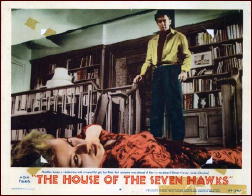
Well in point of fact, Morrow published it and it was bought by no less than MGM, who packaged it as a medium-budget flick for their declining star Robert Taylor in 1959, adapted by Jo Eisinger and directed by that reliable workhorse Richard Thorpe. Just a few years earlier, Thorpe and Taylor had worked together on big-budget extravaganzas like IVANHOE and KNIGHTS OF THE ROUND TABLE, but here they were clearly just treading water.
For most of its length, THE HOUSE OF THE SEVEN HAWKS (as they wisely re-titled it) is as undistinguished a movie as the book was a book. Except for Taylor, there are no big stars or even any memorable character actors. The chase scenes and sea-going stuff are jettisoned for reasons of economy, and the stunt work in the fights could be charitably described as duller than ditchwater. Yet HAWKS stayed in my memory for years, and I don’t know whether to blame Director Thorpe or Writer Eisinger — or to praise them.
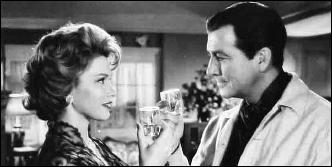
The thing is this: about 20 minutes in, HAWKS segues into a fugue from THE MALTESE FALCON; Taylor (now named John Nordley for some reason!) is approached by an effeminate little perfumed man with a cane who works for a fat, loquacious boss associated with a lying femme fatale. Big chunks of dialogue are ripped from FALCON, with the fat man AND Taylor bluffing about what they need to find out, and later Taylor tells the femme what a good actress she is … then they kiss and he sees the fat man’s henchman outside the window, just as in FALCON.
Like I say, I don’t know who was responsible for this wholesale rip-off/homage, but it’s worth remembering that Thorpe once re-shot the 1937 PRISONER OF ZENDA scene for scene. Whatever the case, when I saw this on Network TV back in the late 60s, before videotapes, DVD or even Turner Classic Movies, the blast from a classic seemed delightfully amusing.
Or at least it made the film a little less forgettable.
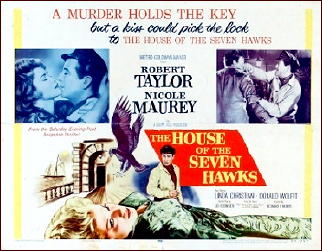
March 20th, 2013 at 8:07 pm
My ability to add my usual selection of images of book covers, posters and the like has been temporarily restricted. Hopefully I’ll be back in full swing in a day or so, but at the moment, I really really hate computers.
March 20th, 2013 at 8:22 pm
I thought Robert Taylor memorable…in a good way. His image in this really has staying power. Otherwise I pretty much agree with everything Dan has written.
March 20th, 2013 at 10:38 pm
I saw HOUSE OF THE SEVEN HAWKS a few years ago and remember noticing that it was influenced by THE MALTESE FALCON.
Sometimes the only thing that makes these films watchable is such an influence; I then find it enjoyable viewing the remake even though it is inferior compared to the original version.
I’m reminded of another MGM movie, CAIRO (1963) starring George Sanders. It is a faithful remake of the American film noir classic THE ASPHALT JUNGLE. But instead of an American city, it takes place in Egypt as Sanders plans to rob King Tut’s jewels from a museum. Eric Pohlmann is also in this film and he puts together a professional team just like in THE ASPHALT JUNGLE: gunman, safecracker, getaway driver, and a bankrupt businessman acting as a fence. The mastermind even has a taste for young girls just like in ASPHALT JUNGLE, only in this case a belly dancer.
Though well acted, the film points out the importance of the director. John Huston was excellent as the director of the original ASPHALT JUNGLE but Wolf Rilla, the director of CAIRO, is not on that level at all.
March 21st, 2013 at 12:29 pm
It took a couple of workarounds to get them included, but it looks like I can post images again. I’ve just added the five you see now.
March 21st, 2013 at 3:15 pm
Jo Eisinger (Jason James) had a thing about the Maltese Falcon. He won an Edgar for his writing on the radio series Adventures of Sam Spade. He used the Falcon characters and plot in an episode from the radio series Cases of Mr. Ace which he adapted for an episode of Cases of Eddie Drake.
March 21st, 2013 at 4:17 pm
michael,
That explains it then! Thanks!
March 22nd, 2013 at 11:06 am
At one time Victor Canning was on a list of writers whom I felt were important enough for me to collect. I guess I changed my mind because I have only one now and have kept it mainly because someone arranged to have him inscribe it to me.
March 22nd, 2013 at 5:40 pm
John Higgins has created an excellent website on Victor Canning, highly recommended: http://myweb.tiscali.co.uk/wordscape/canning/
He has also published four Canning short story collections via Lulu.com and edited the Crippen & Landru collection The Minerva Club. All are well worth seeking out.
March 22nd, 2013 at 5:52 pm
I have just spotted that John Higgins has put a link to this review on the page about the book. http://myweb.tiscali.co.uk/wordscape/canning/seven%20flies.html
One error though, the book was not published first as a cheap edition in the UK, I have a copy of the first edition in dust-jacket. The title used in the serialization in the Saturday Evening Post was HOUSE OF FEAR
March 22nd, 2013 at 9:01 pm
My goodness, John Higgins sure is fast! I don’t know how he did it, but it didn’t take him long to spot Dan’s review. Thanks for the links and other info, Jamie.
April 2nd, 2013 at 10:10 am
I would be grateful if Jamie Sturgeon could email me a scan of his first edition dust jacket to marlodge1@gmail.com, hopefully not price-clipped. I think I may have been sold a first edition of the book with a cheap edition dust jacket.
John
April 2nd, 2013 at 1:33 pm
John
I’ve forwarded your request on to Jamie. I hope he can help you out!
— Steve
April 3rd, 2013 at 3:55 am
Jamie has come up trumps and explained something that puzzled me, how a first edition book can turn up in a cheap edition dust jacket (publishers had leftover stock, of course). Thanks to all.
John
June 27th, 2013 at 2:15 pm
While browsing through some clippings I came across the following review by Anthony Boucher in the New York Times Book Review from Sept 26, 1952: “Minority report: Victor Canning’s The House of the Seven Flies is a dull, wordy and trite adventure novel, with a thin plot concerning the recovery of Nazi war loot, a cardboard set of villains, and a marked lack of surprising twists. I say ‘minority’ because all Canning seems equally uninteresting to me, while such a discriminating, if generous, critic as Dorothy B. Hughes finds that he ‘has taken over the place which Eric Ambler held prior to World War II as the only worthy artist writing of the confidential agent.’ I suppose you’d better make up your own mind–and in any case, if you really want a worthy artist writing of a confidential agent, don’t miss Mrs. Hughes’ own recent ‘The Davidian Report.'”